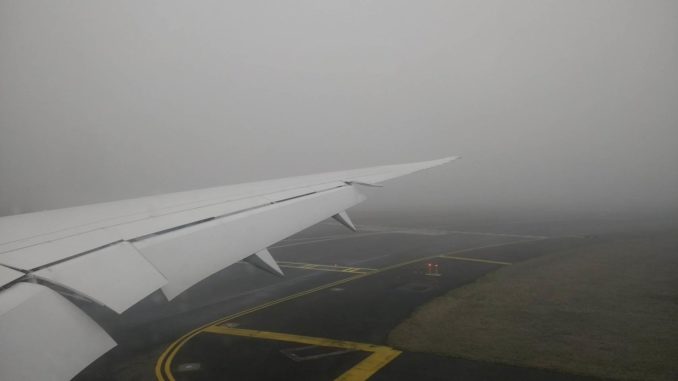
With the recent weather at Cardiff Airport causing diversions due to fog we thought it was time for our resident MET guru Philip Dawson to look at why fog has so much of an effect on air travel and what the limitations are on flying, and more importantly, landing in fog.
LOW VISIBILTY OPERATIONS
The incidence of fog at an airfield effectively removes all visual reference and thus can cause massive disruption to an airline’s operation, not to mention increased costs, through delays caused by diversions away from the target airfield.
Whilst there are several different types of fog, essentially all fog is cloud at or near the surface.
A check of weather data for Cardiff Airport (CWL/EGFF) and Bristol Airport (BRS/EGGD) airfields going back 40 years shows that the average incidence of fog is 50 days and 71 days per year respectively. The higher incidence at Bristol Airport can be explained quite simply by the fact that the elevation of Bristol Airport is some 402 feet higher than Cardiff Airport and thus is more prone to having its head in the clouds.
Interestingly, whilst the incidence of fog at Cardiff Airport is decreasing decade on decade, the same can not be said for Bristol Airport where it is increasing. I should add that this data reflects days that fog was reported at the airfield and not necessarily that flying was disrupted as a result.
So it can be seen that Bristol Airport, hosting major based airlines, had a strong commercial case when it came to them installing a Cat IIIb capable ILS; a decision that has saved countless diversions and associated costs for both the airport and the airlines that use it. Note however that the Cat IIIb capability only applies to Runway 27, the dominant runway, whilst Runway 09 ILS is Cat I, the same as Cardiff Airport.
Cardiff Airport on the other hand has just a CAT I ILS system on both runways. This means that, with the higher landing minima applied compared to Cat III ILS, Cardiff Airport’s fewer incidences of fog lead to proportionally greater disruption compared to Bristol Airport.
Successive Cardiff Airport managements have never been able to justify the costs of installing CAT III ILS in view of the relatively small throughput of traffic. However, I suspect that it might well be a bargaining tool should an airline wish to set up a large operation at Cardiff Airport in future.
USE OF CAT IIIb ILS
Just because an airfield may have a CAT III ILS installed, does not mean that anyone can use it. There are very strict controls and conditions to satisfy first.
- a) Serviceability – both the ground and aircraft systems components have to be fully serviceable.
- b) Crew Training – BOTH pilots must be fully trained and current on ILS approach procedures.
- c) Not all aircraft types are ILS compatible with an airfield’s CAT III capabilities.
- d) The airfield must be satisfied that the safety of airfield ground operations will not be compromised by allowing such landings in low or zero visibility.
| Approach category | Decision height | Runway visual range (RVR) | Visibility minimum | Notes |
|---|---|---|---|---|
| I | 200 ft (61 m) or more | 1,800 ft (550 m) ; at some airports 1,210 ft (370 m) is approved. For single crew operations, increased to 2,600 ft (790 m). | 800 m (2,600 ft). | Either visibility not less than 800 m (2,600 ft) or a runway visual range (RVR) not less than 550 meters (1,800 ft) on runway with touchdown zone and centerline lighting.FAA Order 8400.13D allows for special authorization of CAT I ILS approaches to a decision height of 150 feet (46 m) with RVR ≥ 1,400 feet (430 m). The aircraft and crew must be approved for CAT II operations and a heads-up display in CAT II or III mode must be used to the decision height. CAT II/III missed approach criteria apply. |
| II | less than 200 ft and more than 100 ft (30 m) | 1,000 feet (300 m) | N/A | ICAO and FAA: 350 meters (1,150 ft) or EASA: 300 meters (980 ft). |
| IIIa | less than 100 ft and more than 50 ft (15 m) | 600 feet (180 m) | N/A | |
| IIIb | less than 50 ft (15 m) or none | 150 feet (46 m) | N/A | |
| IIIc | No limitations | None | N/A | As of 2012, this category is not yet in operation anywhere in the world, as it requires guidance to taxi in zero visibility as well. Category IIIc is not mentioned in EU-OPS. |
*Table data from Wikipedia.
DIVERSIONS
In conditions that forbid an approach to be made, or when an approach has to be aborted, it will be necessary to make a diversion to an alternate airfield. There are many different and often competing reasons for a particular airfield to be chosen. Notwithstanding that the Commander of the aircraft has the final say on all matters pertaining to his flight, the decisions of where to divert to are often a compromise reached from discussions between the airline Operational and Commercial departments, who have an overview of ‘The Big Picture’, with the occasional input from the aircraft crew via Company radio, but ALWAYS with the safety of the flight as the paramount objective. To that end, the alternate airfield(s) nominated before the flight commences should have an operationally acceptable meteorological forecast, compared to the actual destination airfield. For instance, you would not nominate Bristol Airport as a diversion airfield for Cardiff Airport if the weather there was forecast to be no better than Cardiff Airport, regardless of superior ILS capability. Usually this alternate is Birmingham (BHX/EGBB), if the weather forecast is acceptable, which it usually is, and with a weather eye on perhaps Manchester (MAN/EGCC), East Midlands (EMA/EGNX) or Exeter (EXT/EGTE) as back-up plans. However, the commercial, or passenger convenience preferred diversion alternate decision can sometimes be overruled by upcoming engineering, operational or crewing requirements, meaning that the aircraft may be asked to divert to a main-base airfield where engineers and/or crew are available. Thankfully, this is rare and most decisions have the passengers’ welfare at the forefront.
Flight crew will always know in advance of potential weather problems and will plan their uplift of fuel accordingly to include extra holding fuel and extra alternate fuel based on where they might well end up (not necessarily the alternates shown on the flight plan).

Bristol Airport is 402ft higher than Cardiff Airport. Just saying..
We will remove Bristols extra stature forthwith.